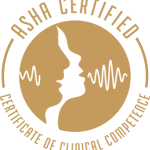

What is Speech Therapy for Accent Modification?

Amy Yacoub, MS, CCC-SLP
- May 27, 2022

We live in a country known and celebrated for its cultural diversity. And that’s reflected in the way we speak. In fact, we each have our own, unique accent. Our accents are part of our individual identity, and can play a role in how others perceive us.
Sometimes, individuals might want to modify their accent for various reasons.
Some people feel that their accent makes it difficult to communicate effectively in social, academic, or work settings. Others may ask them to repeat themselves often and might have trouble understanding a person’s speech due to their accent.
One possible solution to these issues? Through Speech Therapy, individuals can focus on Accent Modification.
What does Speech Therapy for Accent Modification consist of? How can this service benefit those who want to change the way their speech is perceived by others? Let’s explore.
Who is a Candidate?
Our accents reflect a certain area of the country or part of the world where we grew up or have spent a lot of time. If you’d like to change your speech by modifying your accent, then Speech Therapy for Accent Modification is an effective option.
- Professionals who want to communicate more effectively at work.
- Those who avoid certain social interactions because of their accent.
- Non-native English speakers who feel their speech is difficult for others to understand.
- Actors seeking to learn to speak with a different accent to perform a certain role.
- People who want to soften a strong accent so it is not as noticeable.
Start with an Evaluation
Getting started with Accent Modification begins with scheduling a Speech Therapy evaluation.
A Speech Therapist will speak to you about your concerns and what you are hoping to change about your accent.
The Speech Therapist (also known as Speech-Language Pathologist) will also conduct an assessment to determine your current speech patterns . That includes how you articulate different sounds, and the rhythm and tone of your speech.
Following the evaluation, the Speech Therapist will provide you with recommendations for how often you will need to attend therapy sessions for accent modification. For example, one to two sessions per week for 1 hour may be recommended.
Consistent attendance in Speech Therapy is one of the keys to effectively modifying your accent. Teletherapy is a convenient and effective way to help fit weekly sessions into a busy schedule.
A Typical Speech Therapy Session
During Speech Therapy sessions, you will work on certain goals that have been set by the therapist. Those will address the concerns you’ve shared and changes you can make to your speech patterns to modify your accent.
Modifying Sound Pronunciation
You say “to-may-to”, I say “to-mah-to”.
One thing that makes our accents sound unique is the way we pronounce different consonant and vowel sounds.
Known as articulation therapy , Accent Modification in Speech Therapy involves clients learning a new way to pronounce certain sounds.
For example, it can be easy to tell if someone is from the New England region of the U.S. because people with an accent from this area often leave off the “R” sound in words. If someone with this accent wanted to modify it, the Speech Therapist might teach the client how to place the muscles in their mouth to correctly pronounce the “R” sound.
In Accent Modification, clients may be asked to practice pronouncing sounds in a different way while reading words, then sentences, and progressing up to paragraphs and conversation.
Changing Intonation, Rhythm, and Stress
Other factors that make accents distinct are characteristics like the pitches and rhythm of an individual’s speech, and the stress he or she puts on certain sounds, syllables, or words.
When working on modifying one’s accent in Speech Therapy, the client might be instructed to practice using a higher or lower pitch while saying certain words or parts of words. This can make their accent sound different.
Accent modification can also include working on putting more or less emphasis on certain syllables or words. In English, for example, we change the part of the word we stress (like the beginning “ba” in balloon) in a pretty unpredictable pattern. Other languages, such as Spanish, the part of the word to be emphasized is sometimes distinguished with an accent mark.
Frequent repetitions of sounds, words, and sentences that are part of Speech Therapy exercises during sessions and home practice can help individuals modify their accent effectively over time.
Getting Started
Speech Therapy for Accent Modification can help some people improve how effectively and confidently they communicate in professional, educational, and everyday life situations.
Teletherapy is a convenient and effective solution if you or a family member are seeking Speech Therapy services. TherapyWorks offers Speech Therapy through teletherapy (nationwide) with Speech-Language Pathologists experienced in Accent Modification services.
Speech Clarity/Articulation Disorders Public Speaking Skills Gender-Affirming Voice Fluency and Stuttering Executive Function Skills Rehabilitative Services Voice Disorders and Voice Therapy
TherapyWorks also offers Speech Therapy, Occupational and Physical Therapy in person. If you would like to learn more, or discuss your specific needs, please don’t hesitate to reach out to TherapyWorks.
Related posts

Understanding Speech Therapy & ABA Terms

Reasons Parents May Seek ABA for Their Child

Your Child Received an Autism Diagnosis. What’s Next?
Therapyworks.
p: (312) 780-0820 f: (877) 716-4799 [email protected]
- Our therapists
- Join our team
- Get Started
Enter your email below to receive our monthly newsletter.
" * " indicates required fields

Accent Modification
Speech therapy can help you change or reduce your accent.

Everyone has an accent. They’re a natural part of spoken language and are as unique as our fingerprints and voice. People sound "different" to us for a variety of reasons. Some come from another part of the country and carry over features of their original language. Even native speakers from different parts of the country have varying accents. We should all be proud of our accents, as they often reflect our social, cultural, and geographic backgrounds. However, for some individuals, their accent can complicate the clarity of their speech. They may have trouble being understood by others. Their accent may disrupt the natural flow of conversation and reduce their ability to communicate. Often, people with accents feel their listeners are more focused on the accent themselves versus the message they’re trying to convey. This can be a frustrating experience and affect a person's personal and professional life. While accents are not a communication disorder, they are a communication difference. If you’re thinking about changing your accent, this guide can help you make the most informed treatment decision. Read on for an overview of accents, answers to common questions about accent modification, and an explanation of how speech therapy can help.
1 What is an accent?
2 Why do people choose to change their accent?
3 How can speech therapy help reduce or modify accents?
4 How does a speech therapist evaluate your accent?
5 What does accent modification look like?
6 The benefits of Expressable online speech therapy for accent modification
What is an accent?
Different languages have their own unique sound systems. They include how vowels and consonants are used and pronounced, the rhythm and intonation of oral communication, and which sounds occur at the beginning and end of words. When someone learns a new language, these features don’t always carry over. Understanding the key features of your accent, and helping to reduce its unwanted effects, is the goal of accent reduction or modification. While many factors can influence how you speak, accents are commonly grouped by:
Accents of national origin: These types of accents are more common in non-native English speakers who learned English as a second language. For example, someone who only speaks English will often sound different than someone who was born in Italy and learned English later in life.
Regional accents: There are parts of the United States commonly associated with having stronger accents. Think New York, Texas, Mississippi, and Boston. Some people who move from state to state choose to modify how they sound.
It’s worth reiterating that accents are not a speech or language disorder. They’re simply a difference in how one speaks.

Why do people choose to change their accent?
There are many reasons why people decide to reduce or modify their accent. These can include:
Difficulty being understood by others
Frequently having to repeat yourself
Listeners having a negative attitude toward your accent
Attention being focused on your accent versus the message you’re trying to communicate
For all these reasons, and many more, communication challenges can have wide-ranging effects on an individual’s personal and professional life. It may interfere with your social interactions, affect your confidence and self-esteem, impede everyday activities, and be a liability for educational and career advancement.
Speech therapy for accent modification is most commonly sought by people who:
Learned English as a second language
Want to change or reduce their regional accent
Have a desire to articulate more clearly and improve their intelligibility in school or work
Need to develop a new accent (for examples, actors performing in a new role)
How can speech therapy help reduce or modify accents?
Without professional assistance from a native speaker, it can be difficult to self-identify and improve the sounds, phrases, and speech patterns that are part of your accent.
Many people who choose to reduce or modify their accent seek speech therapy services. Speech-language pathologists, also referred to as speech therapists, are communication experts. They are qualified to evaluate your accent and provide coaching and instruction to help improve your communication skills.
For example, they’ll help you better understand the mechanics of your speech and how to adjust your pronunciation. They may instruct you on tongue placement or muscle memory that could be affecting your speech sounds. And if you don’t have a chance to speak English often in your daily life, they’ll help you practice your conversational skills.
In most cases, it’s not realistic to expect that your accent will be completely eliminated, or that you’ll sound exactly like a native English speaker. However, speech therapy can help increase your intelligibility so you can be better understood by others. Improving your communication can also relieve the burden brought on by your accent, so it’s less of a distraction during everyday interactions.
How does a speech therapist evaluate your accent?
Your speech therapist will start by comprehensively evaluating your accent and speech patterns. They’ll ask you to produce different sounds and read words and sentences out loud to develop a better understanding of:
How you produce different sounds
The rhythm and intonation of your speech
How you sound in conversation
How your accent impacts your daily life
Your overall intelligibility
They may also ask questions about your personal language history that could be relevant to your care. These can include:
The languages you speak
Age at which you learned new languages
Where these languages were learned (school, home, community)
How long you've spoken each language
Which languages are used at home, work, or socially
Based on this information, as well as your age, linguistic and cultural background, and learning style, your speech therapist will develop an accent modification care plan to help reach your communication goals. Your plan will include pronunciation training, at-home exercises to reinforce what you're learning, and clear objectives to demonstrate progress.
What does accent modification look like?
Depending on your evaluation and communication goals, there are many different techniques your speech therapist may use to modify your accent. According to the American Speech-Language-Hearing Association (ASHA), some of these strategies include:
Listening and imitating: Your speech therapist may have you practice repeating certain sounds or words
Phonetic training: This refers to an individual’s ability to recognize and produce certain sounds
Minimal pair drill: This is the ability to isolate and differentiate between similar sounds
Visual aids: There are a number of visual aids, such as pictures, mirrors, or charts, that can help with the proper pronunciation of sounds
Tongue twisters: Repeating phrases that have similar and successive sounds
Reading: Practicing reading words or text aloud
Recording speech: Your speech therapist may record, or ask you to record, your speech patterns so you can clearly hear yourself speaking and provide feedback
Practicing vowels: Improving how you pronounce and put stress on different vowels
Auditory description: This strategy focuses on your ability to recognize, differentiate, and isolate between separate sounds
The benefits of Expressable online speech therapy for accent modification
Online speech therapy for accent modification is an effective alternative to more traditional, in-person settings. Instead of meeting with your speech therapist in person, you connect with them virtually through video chat. While you’ll receive the same quality of care, online speech therapy is often more affordable than in-person therapy.
Online speech therapy is also more convenient. Many people who choose to modify their accent do so for professional or educational reasons. They have busy working or academic lives, not to mention family responsibilities, which can make commuting to a speech therapist inconvenient. With online speech therapy, not only can you meet with a qualified speech therapist from the comfort of your home, you're not beholden to the limited business hours of many clinics. You can schedule sessions around your busy life--mornings, evenings, or weekends.
Watch learning jump (leap! spring! hop!) from your sessions into the real world.

Learn more about All topics
SMART American Accent Training for Native Spanish Speakers
Comprehensive course focusing on accent error patterns for native spanish speakers, course curriculum, introduction, chapter 1: getting started with pronunciation and intonation targets, chapter 2: final d (pronunciation), small talk (intonation), and how to practice, chapter 3: top consonant errors for native spanish speakers: y and j, sh and ch, v and b, chapter 4: final z (pronunciation), stress content words (intonation), and generalization, chapter 5: the american r (pronunciation), word and syllable stress (intonation and pronunciation), nouns and verbs (intonation and pronunciation)), chapter 6: american th -voiced and voiceless (pronunciation), repeated phrase practice (generalization skill), chapter 7: american vowel sounds (overview pronunciation lesson), vowel /ɪ/ (pronunciation), vowel length (intonation), chapter 8: top vowel differences for native spanish speakers (vowel a /æ/, vowel eh /ɛ/, vowel ay /ei/) (pronunciation), chapter 9: integrating skills for real american speech (consonant clusters, linking and reduced sounds, sentence level intonation), chapter 10: next level skills ("real talk," soft skills, business idioms, business and tech vocabulary) and course feedback.
- Welcome to Your Course! FREE PREVIEW Overview of Accent Patterns for Native Spanish Speakers FREE PREVIEW What Makes an Accent?
- Bonus Video: How Americans say Final T FREE PREVIEW Lesson 2: Word Stress Carries Meaning (Intonation) Lesson 1: Word Endings (Pronunciation)
- Lesson 3: Final D (Pronunciation Target) Lesson 4: Small Talk (Intonation Practice) Lesson 5: How to Practice Final D Pronunciation, Small Talk Intonation MP3's
- Lesson 6: Y and J (Pronunciation) Lesson 7: SH and CH (Pronunciation) Lesson 8: V and B (Pronunciation) FREE PREVIEW Bonus Lesson for B and V (Vowel vs. Bowel) Y and J, SH and Ch, V and B Pronunciation MP3's Bonus Video: S-Blends
- Lesson 9: Final Z (Pronunciation Target) Lesson 10: Stress Content Words (Intonation Practice) Lesson 11: Generalization (How to Take Your Skills to the Next Level) Bonus Lesson: Initial Z Final Z Pronunciation MP3's (with bonus initial Z MP3's)
- Lesson 12: The American R Sound (Pronunciation Target) Lesson 13: Word and Syllable Stress (Intonation and Pronunciation Practice) Lesson 14: Nouns and Verbs (Intonation and Pronunciation) American R Pronunication, Syllable Stress Intonation MP3's
- Lesson 15: Voiceless Th /θ/ (Pronunciation Target) Lesson 16: Voiced Th /ð/ (Pronunciation Target) Bonus Video: Are you pronouncing the most frequently used word in English correctly? Lesson 17: Repeated Phrase Practice (Pronunication, Intonation and Generalization) American TH Downloads
- Lesson 18: American Vowel Sounds (Overview) Lesson 19: Vowel /ɪ/ and Vowel /i/ (Pronunciation Target) Lesson 20: Vowel Length (Stressed Words, Syllables, and Before Voiced Consonants) (Pronunciation and Intonation) Vowel /i/ and Vowel /ɪ/ MP3's Bonus Video: Vowel Schwa /ə,ʌ/
- Lesson 21: Vowel A /æ/ (Pronunciation Target) FREE PREVIEW Lesson 22: Vowel Eh /ɛ/ (Pronunciation Target) Lesson 23: Vowel Ay /ei/ (Pronunciation Target) Bonus Video: Vowel U /ʊ/ Vowel A, Vowel Eh, Vowel Ay Downloads
- Lesson 24: Consonant Clusters: Past Tense (Pronunciation Target, Skills Integration) Lesson 25: Linking (Skills Integration) Lesson 26: Sentence Level Intonation (Intonation Practice, Skills Integration) Past Tense, Linking Final T MP3's Sentence Level Intonation Practice (Lesson 26 PDF)
- Lesson 27: "Real Talk" (Integrated Skills, Generalization) Lesson 28: Soft Skills for Professionals - Introducing Yourself, Direct and Indirect Language (Integrated Skills) Lesson 29: Business Idioms (Integrated Skills) Lesson 30: Business and Tech Vocabulary (Integrated Skills, Generalization) Bonus Video: More Real Talk for Everyday Language Course Feedback Business and Tech Word practice, sorted by Pronunciation Targets
Pricing options
Select the plan that works best for you..

Speech Language Pathologist
Christine dunbar.
Mobile Menu Overlay
The White House 1600 Pennsylvania Ave NW Washington, DC 20500
FACT SHEET: President Biden Takes Action to Protect American Workers and Businesses from China’s Unfair Trade Practices
President Biden’s economic plan is supporting investments and creating good jobs in key sectors that are vital for America’s economic future and national security. China’s unfair trade practices concerning technology transfer, intellectual property, and innovation are threatening American businesses and workers. China is also flooding global markets with artificially low-priced exports. In response to China’s unfair trade practices and to counteract the resulting harms, today, President Biden is directing his Trade Representative to increase tariffs under Section 301 of the Trade Act of 1974 on $18 billion of imports from China to protect American workers and businesses. The Biden-Harris Administration’s Investing in America agenda has already catalyzed more than $860 billion in business investments through smart, public incentives in industries of the future like electric vehicles (EVs), clean energy, and semiconductors. With support from the Bipartisan Infrastructure Law, CHIPS and Science Act, and Inflation Reduction Act, these investments are creating new American jobs in manufacturing and clean energy and helping communities that have been left behind make a comeback. As President Biden says, American workers and businesses can outcompete anyone—as long as they have fair competition. But for too long, China’s government has used unfair, non-market practices. China’s forced technology transfers and intellectual property theft have contributed to its control of 70, 80, and even 90 percent of global production for the critical inputs necessary for our technologies, infrastructure, energy, and health care—creating unacceptable risks to America’s supply chains and economic security. Furthermore, these same non-market policies and practices contribute to China’s growing overcapacity and export surges that threaten to significantly harm American workers, businesses, and communities. Today’s actions to counter China’s unfair trade practices are carefully targeted at strategic sectors—the same sectors where the United States is making historic investments under President Biden to create and sustain good-paying jobs—unlike recent proposals by Congressional Republicans that would threaten jobs and raise costs across the board. The previous administration’s trade deal with China failed to increase American exports or boost American manufacturing as it had promised. Under President Biden’s Investing in America agenda, nearly 800,000 manufacturing jobs have been created and new factory construction has doubled after both fell under the previous administration, and the trade deficit with China is the lowest in a decade—lower than any year under the last administration. We will continue to work with our partners around the world to strengthen cooperation to address shared concerns about China’s unfair practices—rather than undermining our alliances or applying indiscriminate 10 percent tariffs that raise prices on all imports from all countries, regardless whether they are engaged in unfair trade. The Biden-Harris Administration recognizes the benefits for our workers and businesses from strong alliances and a rules-based international trade system based on fair competition. Following an in-depth review by the United States Trade Representative, President Biden is taking action to protect American workers and American companies from China’s unfair trade practices. To encourage China to eliminate its unfair trade practices regarding technology transfer, intellectual property, and innovation, the President is directing increases in tariffs across strategic sectors such as steel and aluminum, semiconductors, electric vehicles, batteries, critical minerals, solar cells, ship-to-shore cranes, and medical products. Steel and Aluminum The tariff rate on certain steel and aluminum products under Section 301 will increase from 0–7.5% to 25% in 2024. Steel is a vital sector for the American economy, and American companies are leading the future of clean steel. Recently, the Biden-Harris Administration announced $6 billion for 33 clean manufacturing projects including for steel and aluminum, including the first new primary aluminum smelter in four decades, made possible by the Bipartisan Infrastructure Law and the Inflation Reduction Act. These investments will make the United States one of the first nations in the world to convert clean hydrogen into clean steel, bolstering the U.S. steel industry’s competitiveness as the world’s cleanest major steel producer. American workers continue to face unfair competition from China’s non-market overcapacity in steel and aluminum, which are among the world’s most carbon intensive. China’s policies and subsidies for their domestic steel and aluminum industries mean high-quality, low-emissions U.S. products are undercut by artificially low-priced Chinese alternatives produced with higher emissions. Today’s actions will shield the U.S. steel and aluminum industries from China’s unfair trade practices. Semiconductors The tariff rate on semiconductors will increase from 25% to 50% by 2025. China’s policies in the legacy semiconductor sector have led to growing market share and rapid capacity expansion that risks driving out investment by market-driven firms. Over the next three to five years, China is expected to account for almost half of all new capacity coming online to manufacture certain legacy semiconductor wafers. During the pandemic, disruptions to the supply chain, including legacy chips, led to price spikes in a wide variety of products, including automobiles, consumer appliances, and medical devices, underscoring the risks of overreliance on a few markets. Through the CHIPS and Science Act, President Biden is making a nearly $53 billion investment in American semiconductor manufacturing capacity, research, innovation, and workforce. This will help counteract decades of disinvestment and offshoring that has reduced the United States’ capacity to manufacture semiconductors domestically. The CHIPS and Science Act includes $39 billion in direct incentives to build, modernize, and expand semiconductor manufacturing fabrication facilities as well as a 25% investment tax credit for semiconductor companies. Raising the tariff rate on semiconductors is an important initial step to promote the sustainability of these investments. Electric Vehicles (EVs) The tariff rate on electric vehicles under Section 301 will increase from 25% to 100% in 2024. With extensive subsidies and non-market practices leading to substantial risks of overcapacity, China’s exports of EVs grew by 70% from 2022 to 2023—jeopardizing productive investments elsewhere. A 100% tariff rate on EVs will protect American manufacturers from China’s unfair trade practices. This action advances President Biden’s vision of ensuring the future of the auto industry will be made in America by American workers. As part of the President’s Investing in America agenda, the Administration is incentivizing the development of a robust EV market through business tax credits for manufacturing of batteries and production of critical minerals, consumer tax credits for EV adoption, smart standards, federal investments in EV charging infrastructure, and grants to supply EV and battery manufacturing. The increase in the tariff rate on electric vehicles will protect these investments and jobs from unfairly priced Chinese imports. Batteries, Battery Components and Parts, and Critical Minerals The tariff rate on lithium-ion EV batteries will increase from 7.5%% to 25% in 2024, while the tariff rate on lithium-ion non-EV batteries will increase from 7.5% to 25% in 2026. The tariff rate on battery parts will increase from 7.5% to 25% in 2024. The tariff rate on natural graphite and permanent magnets will increase from zero to 25% in 2026. The tariff rate for certain other critical minerals will increase from zero to 25% in 2024. Despite rapid and recent progress in U.S. onshoring, China currently controls over 80 percent of certain segments of the EV battery supply chain, particularly upstream nodes such as critical minerals mining, processing, and refining. Concentration of critical minerals mining and refining capacity in China leaves our supply chains vulnerable and our national security and clean energy goals at risk. In order to improve U.S. and global resiliency in these supply chains, President Biden has invested across the U.S. battery supply chain to build a sufficient domestic industrial base. Through the Bipartisan Infrastructure Law, the Defense Production Act, and the Inflation Reduction Act, the Biden-Harris Administration has invested nearly $20 billion in grants and loans to expand domestic production capacity of advanced batteries and battery materials. The Inflation Reduction Act also contains manufacturing tax credits to incentivize investment in battery and battery material production in the United States. The President has also established the American Battery Materials Initiative, which will mobilize an all-of-government approach to secure a dependable, robust supply chain for batteries and their inputs. Solar Cells The tariff rate on solar cells (whether or not assembled into modules) will increase from 25% to 50% in 2024. The tariff increase will protect against China’s policy-driven overcapacity that depresses prices and inhibits the development of solar capacity outside of China. China has used unfair practices to dominate upwards of 80 to 90% of certain parts of the global solar supply chain, and is trying to maintain that status quo. Chinese policies and nonmarket practices are flooding global markets with artificially cheap solar modules and panels, undermining investment in solar manufacturing outside of China. The Biden-Harris Administration has made historic investments in the U.S. solar supply chain, building on early U.S. government-enabled research and development that helped create solar cell technologies. The Inflation Reduction Act provides supply-side tax incentives for solar components, including polysilicon, wafers, cells, modules, and backsheet material, as well as tax credits and grant and loan programs supporting deployment of utility-scale and residential solar energy projects. As a result of President Biden’s Investing in America agenda, solar manufacturers have already announced nearly $17 billion in planned investment under his Administration—an 8-fold increase in U.S. manufacturing capacity, enough to supply panels for millions of homes each year by 2030. Ship-to-Shore Cranes The tariff rate on ship-to-shore cranes will increase from 0% to 25% in 2024. The Administration continues to deliver for the American people by rebuilding the United States’ industrial capacity to produce port cranes with trusted partners. A 25% tariff rate on ship-to-shore cranes will help protect U.S. manufacturers from China’s unfair trade practices that have led to excessive concentration in the market. Port cranes are essential pieces of infrastructure that enable the continuous movement and flow of critical goods to, from, and within the United States, and the Administration is taking action to mitigate risks that could disrupt American supply chains. This action also builds off of ongoing work to invest in U.S. port infrastructure through the President’s Investing in America Agenda. This port security initiative includes bringing port crane manufacturing capabilities back to the United States to support U.S. supply chain security and encourages ports across the country and around the world to use trusted vendors when sourcing cranes or other heavy equipment. Medical Products The tariff rates on syringes and needles will increase from 0% to 50% in 2024. For certain personal protective equipment (PPE), including certain respirators and face masks, the tariff rates will increase from 0–7.5% to 25% in 2024. Tariffs on rubber medical and surgical gloves will increase from 7.5% to 25% in 2026. These tariff rate increases will help support and sustain a strong domestic industrial base for medical supplies that were essential to the COVID-19 pandemic response, and continue to be used daily in every hospital across the country to deliver essential care. The federal government and the private sector have made substantial investments to build domestic manufacturing for these and other medical products to ensure American health care workers and patients have access to critical medical products when they need them. American businesses are now struggling to compete with underpriced Chinese-made supplies dumped on the market, sometimes of such poor quality that they may raise safety concerns for health care workers and patients. Today’s announcement reflects President Biden’s commitment to always have the back of American workers. When faced with anticompetitive, unfair practices from abroad, the President will deploy any and all tools necessary to protect American workers and industry.
Stay Connected
We'll be in touch with the latest information on how President Biden and his administration are working for the American people, as well as ways you can get involved and help our country build back better.
Opt in to send and receive text messages from President Biden.

- Readout of Ambassador Katherine Tai’s Meeting With Peru’s Minister of Foreign Trade and Tourism Elizabeth Galdo Marín
- Ambassador Tai to Travel to Phoenix, Arizona
- The Office of the U.S. Trade Representative, Small Business Administration, and Department of Commerce Convene the Third USMCA Small and Medium-Sized Enterprise Dialogue
- ICYMI: U.S. Trade Representative Katherine Tai Delivers Remarks on Her Actions to Increase China Tariffs
U.S. Trade Representative Katherine Tai to Take Further Action on China Tariffs After Releasing Statutory Four-Year Review
- USTR Invites Public Participation in Stakeholder Listening Session During Fifth United States-Kenya Strategic Trade and Investment Partnership Negotiating Round
- USMCA Rapid Response Labor Mechanism Panel Releases Determination Regarding Grupo México Mine; Biden-Harris Administration Will Continue Seeking to Enforce USMCA Labor Obligations and Advance Workers’ Rights
- Ambassador Tai to Travel to Arequipa, Peru
- Week Ahead Guidance for the Week of May 13 to May 17, 2024
- United States and Kenya to Hold Fifth Negotiating Round Under their Strategic Trade and Investment Partnership
- Ambassador Tai to Travel to Los Angeles, California
- United States and the Philippines Hold Agriculture and Labor Working Group Meetings Under the Trade and Investment Framework Agreement
- Readout of the U.S.-Iraq Trade and Investment Framework Agreement (TIFA) Council Meeting
- USTR Announces Neil Beck as Acting Assistant U.S. Trade Representative for WTO and Multilateral Affairs
- Week Ahead Guidance for the Week of May 6 to May 10, 2024
- Statement from Ambassador Katherine Tai in Recognition of International Workers’ Day
- Readout of Negotiating Round Under the U.S.-Taiwan Initiative on 21st-Century Trade
- Statement from Ambassador Katherine Tai Celebrating Asian American, Native Hawaiian, and Pacific Islander Heritage Month
- Policy Offices
- Press Office
- Press Releases
May 14, 2024
WASHINGTON – U.S. Trade Representative Katherine Tai today released the following statement concerning the statutory review of the tariff actions in the Section 301 investigation of China’s Acts, Policies, and Practices Related to Technology Transfer, Intellectual Property, and Innovation: “After thorough review of the statutory report on Section 301 tariffs, and having considered my advice, President Biden is directing me to take further action to encourage the elimination of the People’s Republic of China’s unfair technology transfer-related policies and practices that continue to burden U.S. commerce and harm American workers and businesses,” said Ambassador Katherine Tai. “As the President recognizes in his memorandum, while the tariffs have been effective in encouraging the PRC to take some steps to address the issues identified in the Section 301 investigation, further action is required. “In light of President Biden’s direction, I will be proposing modifications to the China tariffs under Section 301 to confront the PRC’s unfair policies and practices. From the beginning of the Biden-Harris Administration, I have been committed to using every lever of my office to promote American jobs and investments, and these recommendations are no different. Today, we serve our statutory goal to stop the PRC’s harmful technology transfer-related acts, policies, and practices, including its cyber intrusions and cyber theft. I take this charge seriously, and I will continue to work with my partners across sectors to ensure any action complements the Biden-Harris Administration’s efforts to expand opportunities for American workers and manufacturers.” The Section 301 statute directs that the four-year review includes a consideration of: the effectiveness of the tariff actions in achieving the objective of the investigation; other actions that could be taken; and the overall effects of the tariff actions on the U.S. economy. The Office of the U.S. Trade Representative’s (USTR) Report addresses the statutory elements of the review, suggests modifications to strengthen the actions, and makes certain recommendations. To encourage further elimination of the PRC’s technology transfer-related acts, policies, and practices, Ambassador Tai has recommended that products from the PRC currently subject to Section 301 tariffs should remain. Additionally, in light of the increased burden on U.S. commerce, President Biden is directing Ambassador Tai to take action to add or increase tariffs for certain products. As the Report details, Ambassador Tai will propose the following modifications in strategic sectors:
The Report also makes recommendations for: (1) establishing an exclusion process targeting machinery used in domestic manufacturing, including proposals for 19 exclusions for certain solar manufacturing equipment; (2) allocating additional funds to United States Customs and Border Protection for greater enforcement of Section 301 actions; (3) greater collaboration and cooperation between private companies and government authorities to combat state-sponsored technology theft; and (4) continuing to assess approaches to support diversification of supply chains to enhance our own supply chain resilience. President Biden is also directing Ambassador Tai to establish an exclusion process for machinery used in domestic manufacturing and to prioritize, in particular, exclusions for certain solar manufacturing equipment. Next week, USTR will issue a Federal Register notice announcing procedures for interested persons to comment on the proposed modifications and information concerning an exclusion process for machinery used in domestic manufacturing. Background In May 2022, USTR commenced the statutory four-year review process by notifying representatives of domestic industries that benefit from the tariff actions of the possible termination of those actions and of the opportunity for the representatives to request continuation. In September 2022, USTR announced that because requests for continuation were received, the tariff actions had not terminated and USTR would conduct a review of the tariff actions. USTR opened a docket on November 15, 2022, for interested persons to submit comments with respect to a number of considerations concerning the review. USTR received nearly 1,500 comments. As part of the statutory review process, throughout 2023 and early 2024, USTR and the Section 301 Committee (a staff-level body of the USTR-led, interagency Trade Policy Staff Committee) held numerous meetings with agency experts concerning the review and the comments received. Specifically, the Report concludes:
- The Section 301 actions have been effective in encouraging the PRC to take steps toward eliminating some of its technology transfer-related acts, policies, and practices and have reduced some of the exposure of U.S. persons and businesses to these technology transfer-related acts, policies, and practices.
- The PRC has not eliminated many of its technology transfer-related acts, policies, and practices, which continue to impose a burden or restriction on U.S. commerce. Instead of pursuing fundamental reform, the PRC has persisted, and in some cases become aggressive, including through cyber intrusions and cybertheft, in its attempts to acquire and absorb foreign technology, which further burden or restrict U.S. commerce.
- Economic analyses generally find that tariffs (particularly PRC retaliation) have had small negative effects on U.S. aggregate economic welfare, positive impacts on U.S. production in the 10 sectors most directly affected by the tariffs, and minimal impacts on economy-wide prices and employment.
- Negative effects on the United States are particularly associated with retaliatory tariffs that the PRC has applied to U.S. exports.
- Critically, these analyses examine the tariff actions as isolated policy measures without reference to the policy landscape that may be reinforcing or undermining the effects of the tariffs.
- Economic analyses, including the principal U.S. Government analysis published by the U.S. International Trade Commission, generally find that the Section 301 tariffs have contributed to reducing U.S. imports of goods from the PRC and increasing imports from alternate sources, including U.S. allies and partners, thereby potentially supporting U.S. supply chain diversification and resilience.

- 600 17th Street NW
- Washington, DC 20508

- Reports and Publications
- Fact Sheets
- Speeches and Remarks
- Blog and Op-Eds
- The White House Plan to Beat COVID-19
- Free Trade Agreements
- Organization
- Advisory Committees
- USTR.gov/open
- Privacy & Legal
- FOIA & Privacy Act
- Attorney Jobs

IMAGES
COMMENTS
I truly believe that in the professional context my accent is significantly better and my pronunciation is much much closer to the native one. Speech Modification provides American Accent Training to Individuals and Corporate Groups. Online training, online video courses, and practice materials and resources to improve your American Accent.
Speech Modification: SMART American Accent Training. Speak fluent English like a native speaker. Pronunciation and intonation of American English made simple, with Speech Language Pathologist ...
Changing your accent is also known as accent modification. It can be hard to change your accent on your own. A speech-language pathologist, or SLP, can help. SLPs work with: People who speak English as a second language. People who want to change their regional accent. Professionals who want to communicate better at work.
Speak English Fluently: Using He'll for He Will. 12/16/2023. Native speakers of American English typically don't say "he will." Instead, we use the contraction "he'll." It has 3 different pronunciations, depending on the context in which it is used. How to Pronounce (and use) He'll in Fluent English Speaking.
Accent modification is an elective service sought by individuals who want to change or modify their speech. Accents are systematic variations in the execution of speech characterized by differences in phonological and/or prosodic features that are perceived as different from any native, standard, regional, or dialectal form of speech (Valles ...
Chapter 2: Intonation. Sounds of American English SMART American Accent 6 Week Course Word of the Day: FREE COURSE REAL TALK, How American Use Linking and Reduced Sounds in Fluent Speech. Welcome to your course!
Speech Modification is the most important class for all international students, workers and non-native English speakers. It was the most interesting, helpful, useful, and professional class I have ever taken before."
SPEECH MODIFICATION AMERICAN ACCENT TRAINING. Home Our Training Online Courses Free Resources CLIENT AREA Contact Store Online Courses. 3/14/2017 We now offer a full range of online courses. The online courses have a step-by-step curriculum to walk you through your American accent training. ...
A certified accent modification instructor with a master's degree in speech pathology is the most qualified accent specialist to help with your communication concerns. Speech-language pathologists are communication experts. It is natural for us to work with individuals who would like to reduce an accent.
SMART American Accent Training with Speech Modification.Start your free trial of our courses: https://courses.speechmodification.com/Join this channel to get...
Free Live Q & A Classes for American English Pronunciation, Intonation and Accent. Ask your questions in chat, get free resources and improve your American E...
Speech Modification. 62,482 likes · 2,904 talking about this · 32 were here. SMART American Accent Training: Want to sound American? You can do it! SpeechModification.com.
SPEECH MODIFICATION AMERICAN ACCENT TRAINING. Home Our Training Online Courses Free Resources CLIENT AREA Contact Store Individual Accent Training Group and Corporate Training Self-Study Online Courses Free Downloads Overview of Accent Patterns ...
Speech Therapy for Accent Modification can help some people improve how effectively and confidently they communicate in professional, educational, and everyday life situations. Teletherapy is a convenient and effective solution if you or a family member are seeking Speech Therapy services. TherapyWorks offers Speech Therapy through teletherapy ...
Complete our online assessment. Submit recordings of your speech for a detailed analysis of your accent patterns. Step Two: Feedback Session. Meet with Christine for a 45-minute 1:1 feedback session. We will review your assessment results and the custom course created for your specific needs and goals. Step Three: Your Personal Course
Online speech therapy for accent modification is an effective alternative to more traditional, in-person settings. Instead of meeting with your speech therapist in person, you connect with them virtually through video chat. While you'll receive the same quality of care, online speech therapy is often more affordable than in-person therapy. ...
American Accent Training Online Video course for Professionals from Speech Modification. SMART Videos for improving all aspects of your communication. ... Christine is a nationally certified Speech Language Pathologist with over 20 years experience working with individuals to improve their communication skills. She holds a Masters of Science in ...
Speech modification (including fluency shaping) strategies (Bothe, 2002; Guitar, 1982, 2019) include a variety of techniques aimed at making changes to the timing and tension of speech production or altering the timing of pauses between syllables and words. These modifications are used regardless of whether a particular word is expected to be ...
SMART American Accent Training with Speech Modification.Start your free trial of our courses: https://courses.speechmodification.com/Join this channel to get...
These modifications include a range of acoustic-phonetic (e.g. slower, more intense and hyper-articulated speech) and linguistic adaptations (e.g. higher frequency words, shorter and simpler sentences) often broadly referred to as 'clear speech' (for reviews see [1,2]).
President Biden's economic plan is supporting investments and creating good jobs in key sectors that are vital for America's economic future and national security. China's unfair trade ...
The Office of the U.S. Trade Representative's (USTR) Report addresses the statutory elements of the review, suggests modifications to strengthen the actions, and makes certain recommendations. To encourage further elimination of the PRC's technology transfer-related acts, policies, and practices, Ambassador Tai has recommended that products ...
(The Center Square) - Proposed legislation targeting protestors is expected to get tweaks from the North Carolina House of Representatives, possibly before the Memorial Day holiday weekend.